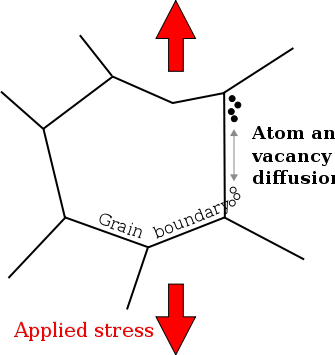
Coble creep
Encyclopedia

Diffusion creep
Diffusion creep refers to the deformation of crystalline solids by the diffusion of vacancies through their crystal lattice. Diffusion creep results in plastic deformation rather than brittle failure of the material....
, is a mechanism for deformation of crystalline solid
Solid
Solid is one of the three classical states of matter . It is characterized by structural rigidity and resistance to changes of shape or volume. Unlike a liquid, a solid object does not flow to take on the shape of its container, nor does it expand to fill the entire volume available to it like a...
s. Coble creep occurs through the diffusion of atoms in a material along the grain boundaries, which produces a net flow of material and a sliding of the grain boundaries.
Coble creep is named after Robert L. Coble, who first reported his theory of how materials creep
Creep (deformation)
In materials science, creep is the tendency of a solid material to slowly move or deform permanently under the influence of stresses. It occurs as a result of long term exposure to high levels of stress that are below the yield strength of the material....
over time in 1962 in the Journal of Applied Physicshttp://scitation.aip.org/getabs/servlet/GetabsServlet?prog=normal&id=JAPIAU000034000006001679000001&idtype=cvips&gifs=yes.
The strain rate in a material experiencing Coble creep is given by:

where
 is the applied stress
is the applied stress is the average grain boundary diameter
is the average grain boundary diameter is the diffusion coefficient in the grain boundary
is the diffusion coefficient in the grain boundary is the activation energy for Coble creep
is the activation energy for Coble creep is the molar gas constant
is the molar gas constant is the temperature in kelvins
is the temperature in kelvins
Note that in Coble creep, the strain rate
 is proportional to the applied stress
is proportional to the applied stress  ; the same relationship is found for Nabarro-Herring creep. However, the two mechanisms differ in their relationship between the strain rate and grain size
; the same relationship is found for Nabarro-Herring creep. However, the two mechanisms differ in their relationship between the strain rate and grain size  . In Coble creep, the strain rate is proportional to
. In Coble creep, the strain rate is proportional to  , whereas the strain rate in Nabarro-Herring creep is proportional to
, whereas the strain rate in Nabarro-Herring creep is proportional to  . Researchers commonly use these relationships to determine which mechanism is dominant in a material; by varying the grain size and measuring how the strain rate is affected, they can determine the value of
. Researchers commonly use these relationships to determine which mechanism is dominant in a material; by varying the grain size and measuring how the strain rate is affected, they can determine the value of  in
in  and conclude whether Coble or Nabarro-Herring creep is dominant[1].
and conclude whether Coble or Nabarro-Herring creep is dominant[1].

